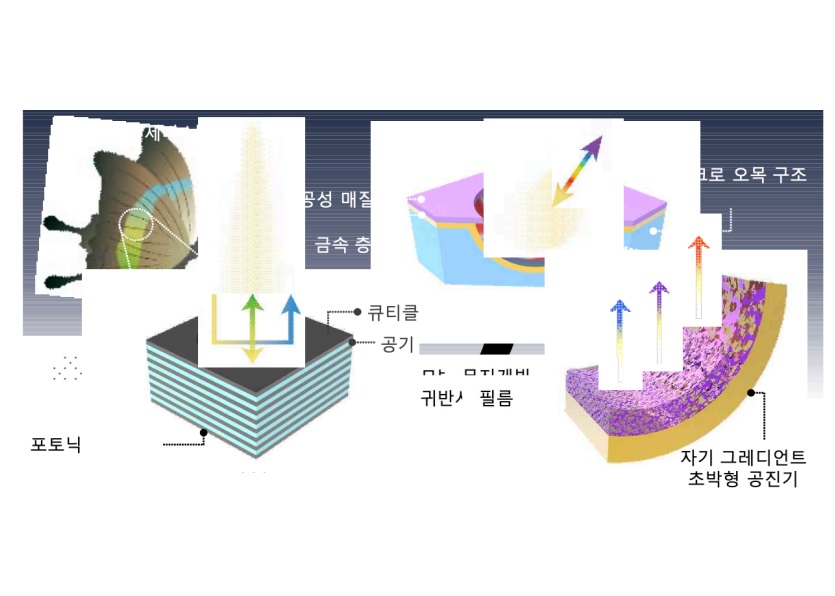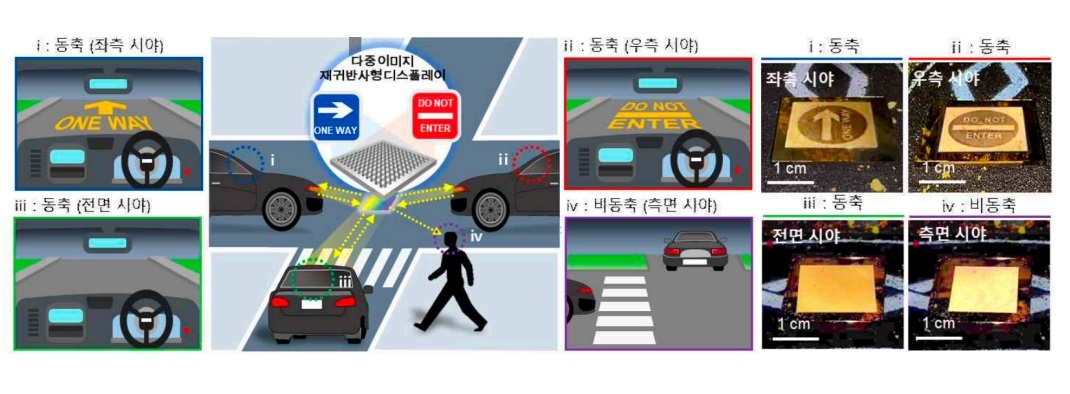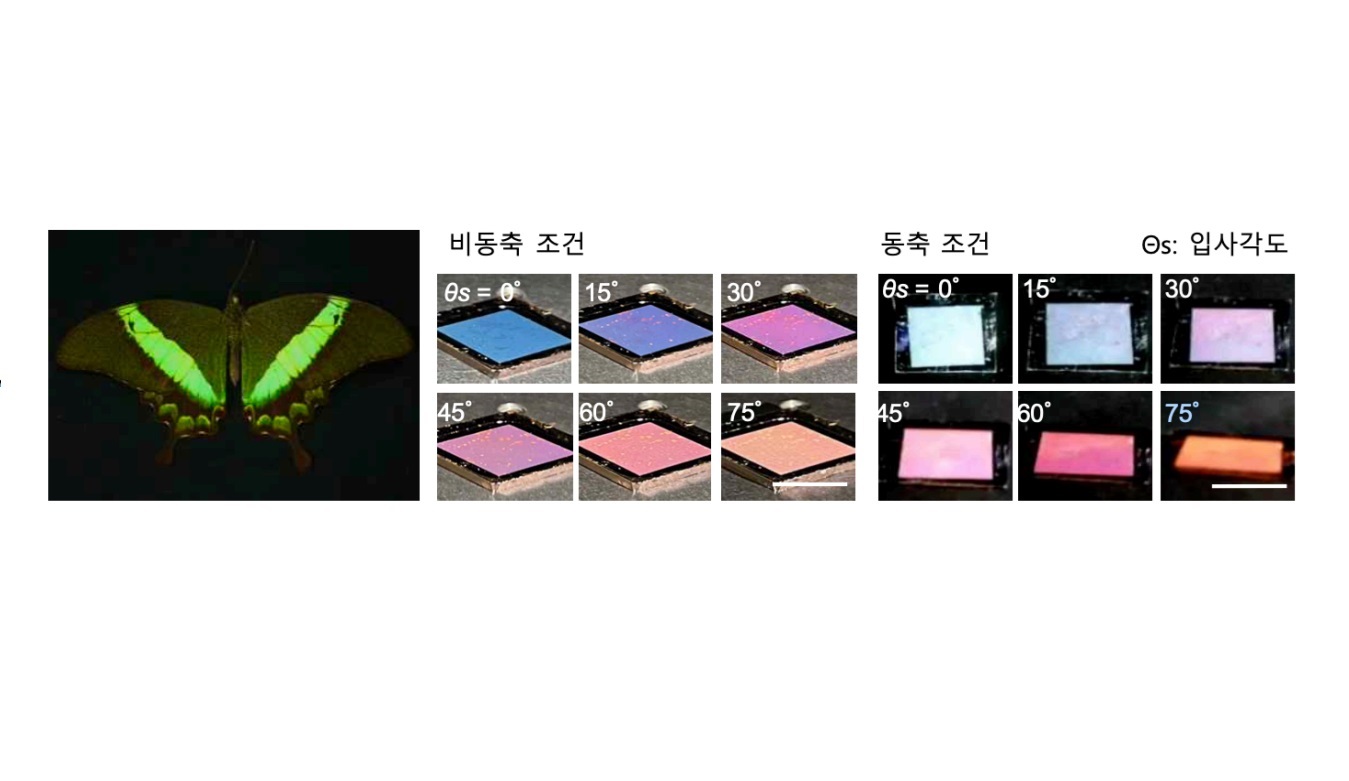2024.06.25
- Developed an ultra-thin retroreflective platform with a simple structure consisting of a metal layer and a porous medium layer by simulating the optical structure of the emerald swallowtail butterfly wing... Confirming vivid rainbow colors under various lighting and observation conditions
- Can be used as an interactive display such as traffic signs that appear differently depending on the direction of intersection, “Expected to develop into a retroreflective display that can adjust pixelated colors”
- Published in 「Biosensors & Bioelectronics」, a renowned international journal in the field of biophysics
At the Gwangju Institute of Science and Technology (GIST, President Kichul Lim), Professor Young Min Song's research team in the School of Electrical Engineering and Computer Science announced that they had developed a display system by utilizing an ultra-thin retroreflective platform with a simple structure imitating the wings of the emerald swallowtail butterfly (Papilio Palinurus) to produce multiple images that change depending on the observation direction.
The result of this research, which overcomes the limitations of the existing biomimetic retroreflective platform, which has iridescent characteristics only under non-coaxial* conditions, is expected for the development of a biomimetic sensor and display with highly visible recognition functions even under difficult conditions such as low-light environments.
Retroreflection is a characteristic that reflects light in the direction it emits no matter which direction it comes from and at any angle, and it is widely used in the production of traffic safety signs and night-time safety equipment.
Hummingbirds, beetles, and some butterflies communicate effectively through patterns and colors, and the wings of the emerald swallowtail butterfly in particular have multiple layers of cuticle* and an air concave structure that allows for the induction of vivid retroreflective colors.
To imitate the wing structure of the emerald swallowtail butterfly, existing studies mainly used an optical structural system combining photonic crystals* and micro-hemisphere arrays. However, these systems have very complex manufacturing processes and have limitations in realizing active and vivid colors.
Achieving vivid color changes with effective retroreflection requires careful structural design and an understanding of structural color in terms of delicate light-matter interactions. For this purpose, a method based on total reflection* due to the difference in refractive index inside and outside the spherical surface in micro units has been studied, but it has the limitation that it has iridescent characteristics only under non-coaxial conditions and that accurate patterning is difficult.
To solve this problem, the research team implemented a retroreflective platform with vivid iridescent colors by adding a porous layer to a simple film-type metal layer.
A structure with gradual porosity* is deposited due to the curvature of the micro-concave structure, and the resulting effective refractive index difference maintains the characteristics of retroreflection and has vivid iridescent colors under various lighting and observation conditions, including coaxial and non-coaxial.
Furthermore, this research outcome has the advantage of wide scalability and the ability to implement various patterns because it implements color using a thin film deposition method.
Based on these advantages, the research team succeeded in implementing an interactive display with a pattern that changes depending on the observation direction by depositing patterns of the porous medium layer at different angles.

Structural characteristics of the biomimetic retroreflective platform developed by the research team. By imitating the wing structure of the emerald swallowtail butterfly, they developed an ultra-thin retroreflective platform with a simple structure consisting of a metal layer and a porous medium layer.
In addition, the optical properties of the color-implementing layer can be designed to suit the intended use to increase versatility in real-world applications. Applications such as hydrogen sensors with enhanced visibility and dynamic color change are possible.
Professor Young Min Song said, "We overcame the structural complexity of existing biomimetic retroreflective platforms and developed a system that displays vivid iridescent colors under various conditions. Above all, it has the potential to develop from an interactive display with multiple images to a retroreflective display that allows pixelated color adjustment. It is expected to be widely applied in the field of multi-functional biomimetic sensors and displays in the future."

Application schematic diagram and measurement results of multi-image retroreflective display. By patterning and depositing porous media layers in different directions, a multi-image display capable of bidirectional observation can be developed. Based on these characteristics, it is expected to be applied to new traffic signs that deliver customized information from various angles according to the direction of the observer and light source.
This research, led by Professor Young Min Song of the School of Electrical Engineering and Computer Science and conducted by postdoctoral researcher Joo Hwan Ko and integrated master's and doctoral student Ji-Eun Yeo, is a mid-sized project promoted by the Ministry of Science and ICT and the National Research Foundation of Korea and was conducted with support from the Future Technology Lab Project, Sejong Science Fellowship, GIST-MIT AI Convergence International Cooperation Project, GIST GRI Project, and International Technology Center Indo-Pacific (ITC IPAC), and the research results were published online on June 2, 2024, in the international academic journal 'Biosensors & Bioelectronics' (IF: 12.6), a top 2.1% journal in the field of biophysics.
* coaxial/non-coaxial: The relationship between the incident light axis and the observation axis. If they have the same axis, they are defined as coaxial, and if they have different axes, they are defined as non-coaxial.
* cuticle: A hard layer produced by secretion from cells on the body surface of an organism.
* photonic crystal: An optical nanostructure whose refractive index changes periodically. A substance that has a structure or is created to have a structure that can utilize the optical properties of the substance.
* total reflection: A phenomenon in which light is completely reflected from a specific surface.
* porosity: The property of having multiple small holes inside or on the surface of a material.





